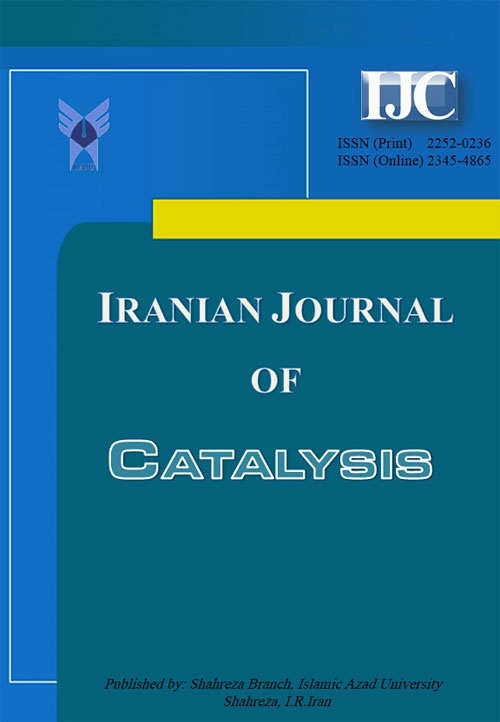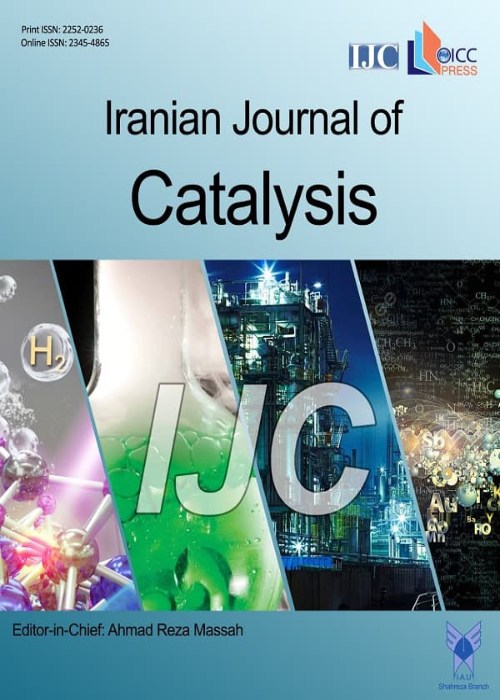فهرست مطالب

Iranian Journal of Catalysis
Volume:9 Issue: 2, Spring 2019
- تاریخ انتشار: 1398/03/11
- تعداد عناوین: 10
-
-
The role of carburization temperature on the molybdenum carbide surface and their catalytic activityPages 91-97The surfaces of molybdenum carbide were varied by changing the carburization temperature between 823 and 1123 K. The surfaces of the catalytic material were investigated using in-situ temperature program carburization followed by temperature program reduction and oxidation. In-situ temperature program oxidation (TPO) showed the surfaces of the catalysts contain a similar amount of carbonaceous deposit, while temperature program reduction (TPR) showed their ability to consume hydrogen in different amounts. The result shows the surface of the carbide at 823 K contained oxygen, while those carburized at higher temperature (≥ 923 K) were pure carbide. The catalysts tested for hydroisomerization of n-heptane and the catalyst with oxycarbide surface showed higher activity and iso-heptane selectivity. Hence, carburization temperature plays a crucial role in the formation of an active catalyst.Keywords: Hydroisomerization, Carburisation temperature, Activity, Reduction, Oxidation
-
Pages 99-108In this work, the photoelectrocatalytic (PEC) degradation of 2,5-dichlorophenol can be used for its removal from aqueous solution. To study this activity, a TiO2 thin film modified titanium sheet (TiO2/Ti) was fabricated by anodizing Ti plates using a two electrode system under the constant bias voltage of 20 V for 20 min in a solution of 0.2% (v/v) HF followed by calcination at 500 oC for 2 h. Then, the electrochemical properties of 2,5-dichlorophenol were compared on the surface of the TiO2/Ti and unmodified Ti electrodes. Consequently, the TiO2/Ti was applied for PEC degradation of 2,5-dichlorophenol. It was found that 2,5-dichlorophenol could be degraded more efficiently by this photoelectrocatalysis process than the sum of degradation obtained by photocatalytic (PC) and electrochemical (EC) oxidation so that the amount of 2,5-dichlorophenol degraded by PEC, PC and EC oxidation were equal to 51%, 39% and 5% respectively under the 0.4 V voltage in 60 min. The effect of various parameters was studied and the highest degradation percentage of 2,5-dichlorophenol was obtained at pH 6.0, the initial 2,5-dichlorophenol concentration of 7.0 mg L-1 and applied potential of 1.2 V.Keywords: 2, 5-Dichlorophenol, Degradation, Photoelectrocatalysis, TiO2, Ti electrode
-
Pages 109-120A green, efficient, chemoselective, facile and clean procedure is described and discussed for the synthesis of α, α'-bis (substituted-benzylidene) cycloalkanones in solvent-free conditions. The condensation reaction was carried out through the reaction of aromatic aldehydes with cycloalkanones in the presence of Fe3O4@WO3 (Fe3O4@WO3-EAE-SO3H (III)) nanoparticles as the catalyst. The nanostructured catalyst with the spherical shape, particle size in the range of 7-23 nm and superparamagnetic behavior may be referred as an excellent replacement for Brønsted acids. The reaction proceeds rapidly at room temperature, giving high yields of products. No self-condensation product was produced. Easy separation of the catalyst from the reaction mixture by means of an external magnetic field and re-using up to seven times without loss of activity are the salient features of the present method.Keywords: α, α'-Bis (substituted-benzylidene) cycloalkanones, Aldehyde, Cycloalkanone
-
Pages 121-132In the current survey, the removal of dye from contaminated water was studied by photocatalytic degradation using TiO2 nanoparticles with respect to pH, TiO2 dosage, reaction time, temperature and initial dye concentration. TiO2 nanoparticles were investigated by XRD, FESEM and FT-IR.The RSM was chosen to study the composition effects of input independent factors and one dependent output response (removal efficiency). The P-value (2.2 × 10−16), F-value (1832), R2 (multiple R-squared: 0.9985, adjusted R-squared: 0.9972), and lack of fit (0.432) indicate that the reduced full second order model is highly significant for dye removal by TiO2 nanoparticles.The maximum percentage removal of dye, 90.2%, was achieved at optimum operating conditions including pH=6.5, TiO2 dose (1.2 g L-1), contact time (67.5 min), temperature ( ), and dye concentrations (55 mg L-1)), respectively.The maximum removal efficiency was calculated to be 100%, using regression coefficients derived from the model and the Solver “Add-ins”.The results indicated that the TiO2 photocatalyst was very proper for the removal dye from contaminated water, and it had good efficiency in eliminating textile dyes.Keywords: TiO2, Photocatalyst, Degradation, Direct blue 71, Optimization, RSM
-
Pages 133-145A suitable model for predicting the product quality of vacuum gas oil (VGO) catalytic hydrocracking is developed. Data were obtained using an experimental catalytic hydrocracking reactor loaded with the Ni-Mo/Al2O3-SiO2 catalyst. A set of experimental runs was conducted under various operating temperatures from 380 to 450 ℃. Three distribution models were used to develop the predictive model. By the discrete lumping model, distillation curves of the cracked products (naphtha, kerosene, diesel, and gas) were obtained using the simulated distillation test. Model validation results showed that the proposed models are capable of predicting the distillation curves of the hydrocracked products accurately. Accuracy and simplicity of the developed model make it suitable to estimate the conversion and also the product distribution of hydrocracking units in refineries.Keywords: VGO, Hydrocracking, Discrete lumping model
-
Pages 147-154The activity of different transitional metals over modified H-ZSM-5 catalysts for methane conversion to aromatics was compared. The first group of catalysts was Mo-impregnated H-ZSM-5 zeolites with 1, 3 and 6 wt% of Mo. The second group was M(3 wt%)- impregnated H-ZSM-5 (M: Ag, Cd, Cr, Mo, Zn and Mn). The catalytic activity of the first group was investigated at 600, 700 and 800 °C and gas hourly space velocity (GHSV) of 1500, 2250, 3600 [ml.g-1.h-1]. Likewise, the second group of catalysts was examined at 700°C and GHSV of 2250 [ml.g-1.h-1]. The catalyst samples were appropriately characterized by XRD, BET and SEM techniques. The effect of loaded transitional metals on the methane conversion was sorted on the basis of benzene yield as following: 3%wt Mo> 3%wt Zn> 3%wt Mn> 3%wt Ag> 3%wt Cd > 3%wt Cr. The highest methane conversion was 11.13% obtained over the Mo(3 wt%)-impregnated HZSM-5 catalyst.Keywords: Natural gas, Dehydro-aromatization, HZSM-5 metal-modified catalyst, Nonoxidative-conversion
-
Pages 155-162Nano-peanut shell‑OSO3H nanoparticles were simply prepared and characterized by the scanning electron microscopy (SEM), transmission electron microscope (TEM), fourier transform infrared (FT-IR), energy dispersive X-ray spectroscopy (EDX), and thermal analysis techniques (TGA/DTG). The catalytic activity of nano-peanut shell‑OSO3H was studied in the synthesis of biologically important 4H-pyran derivatives. The reaction involves the use of Kojic acid, 5,5-dimethyl-1,3-cyclohexanedione, and various benzaldehydes. A wide range of benzaldehydes is compatible in this reaction, producing excellent yields in a short time. The successful synthesis of dihydropyrano[3,2-b]chromenedione derivatives shows that nano-peanut shell‑OSO3H has high catalytic activity and can be effectively used as a green catalyst.Keywords: Nano-peanut shell‑OSO3H, Dihydropyrano[3, 2-b]chromenedione, Kojic acid, Green nanocatalyst
-
Pages 163-171Fe (III) supported graphitic carbon nitride nanocomposite was synthesized by impregnation of FeCl3 with g- C3N4 (Fe (III)@g-C3N4). Then, the synthesis of spirooxindole derivatives was carried out in the presence of Fe (III) @ graphitic carbon nitride nanocompositevia the multi-component reaction of malononitrile, isatins, and 1,3-dicarbonyl compounds in green media (ethanol/water (1:1)) under reflux conditions and the corresponding products were prepared in good to excellent yields (70-98 %). Also, the heterogeneous nanocatalyst was characterized by different techniques including the transmission electron microscopy (TEM), Fourier transform infrared spectroscopy (FT-IR), thermal gravimetric analysis (TGA), atomic absorption spectroscopy (AAS) and X-ray diffraction (XRD). Furthermore, the nanocomposite is recoverable and reusable several times without a negligible decrease in its catalytic performance.Keywords: Graphitic carbon-nitride, Multi-component reaction, Spirooxindole derivatives, Nanocomposite
-
Pages 173-179The expeditious synthesis of 2-aryl-benzothia/(oxa)zoles was carried out by the condensation of 2-aminothiophenol/2-aminophenol and diverse aryl aldehydes in presence of Acacia concinna as a biocatalyst under microwave irradiation. The catalytic process is associated with excellent yields, greener reaction conditions and the environmentally friendly microwave technique which are the striking features of the present protocol.Keywords: Acacia concinna, 2-Aminophenol, 2-Aminothiophenol, 2-Arylbenzothia, (oxa)zoles, Microwave irradiation
-
Pages 181-183Maryam Sadat Ghasemzadeh was born in Ghaen/ Southern Khorasan, Iran. She received her B.Sc. in Pure Chemistry from Imam Khomeini International University and M.Sc. in Organic Chemistry from Birjand University under the supervision of Professor Sara Sobhani. She is currently studying her Ph.D. in Ferdowsi University of Mashhad under the supervision of Professor Batool Akhlaghinia. Her current research focuses on new heterogeneous nanocatalysts to develop new methods of organic synthesis.Keywords: Natural catalysts, Synthesis, Organic compounds


